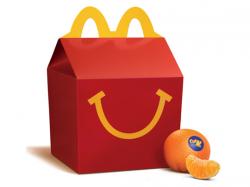Cuties Rollout In McDonald’s Breaks Whole Fruit Barrier
December 18, 2014 | 4 min to read

Cuties began its initial “soft sell” rollout with McDonald’s Happy Meals the week of Thanksgiving and is slated to continue in the fast-food chain’s healthy offering program for kids’ meals through March 1 of 2015 — with a possible extension to the run time.
For Sun Pacific’s president, Bob DiPiazza, the opportunity is a labor of love. Cuties is the first whole fruit being offered as a side option for kids’ meals. The collaboration with Cuties and McDonald’s was approximately three years in the making from initial talks, followed by testing, to the current national rollout.
Early on, before the formal discussion began, DiPiazza heard McDonald’s was looking to include healthy options in its kids’ meals. He began courting the fast-food chain to consider the Cuties Clementines.
“Cuties are an established, fun-favorite fruit for kids, so when our customers told us they would like to see more nutritionally-balanced choices in McDonald’s kids’ meals we listened and partnered with Sun Pacific — a family-owned fruit grower — to deliver California-grown Cuties during their peak season to McDonald’s customers across the country,” says Greg Watson, senior vice president of menu innovation for McDonald’s, based in Oak Brook, IL.
The introduction of Cuties is the latest example that supports McDonald’s ongoing commitment to “champion children’s well-being,” adds Watson. The introduction also supports the chain’s partnership with the Alliance for a Healthier Generation, which is part of the Clinton Global Initiative (CGI) to increase access to fruit, vegetables and low-fat dairy. “Customer response has been very positive, and they are enjoying this new fresh fruit option,” asserts Watson.
Watson explains customers are ordering fries and one of three available choice options: apple slices, Go-GURT’s low-fat Strawberry Yogurt or Cuties. “They also have the option of choosing two fruit offerings and the Go-GURT instead of the fries.”
Although the launch of the Cuties’ kids’ meal side item is still in its infancy, “McDonald’s is currently seeing higher-than-expected results on a la carte purchases of Cuties,” reports Watson.
“We feel good about it,” says DiPiazza regarding the request for individual 50-cent Cuties at McDonald’s.
DiPiazza says McDonald’s did a forecast with Cuties based on the company’s introduction of Go-GURT in order to establish the supply volume for the partnership. To date, Cuties is running ahead of the “Most Likely” forecast number estimated by the chain. “McDonald’s did not share with us the percentage of units they wanted to hit,” says DiPiazza. “We feel if we are running ahead of the projection, then we believe we are performing well.”
For context, according to McDonald’s press release announcing the Cuties option, since March of 2012, McDonald’s started automatically including apple slices in every kids’ meal. Since then, more than 1.2 billion bags of apples were served. In July of 2014, McDonald’s introduced Go-GURT’s low fat Strawberry Yogurt as a side option to its 14,000 U.S. restaurants. Since its rollout, McDonald’s served more than 50 million Go-GURT tubes in kids’ meals.
McDonald’s was very specific and upfront about its food specifications and food safety requirements. “Sun Pacific plants were inspected by McDonald’s food safety folks,” says DiPiazza. “All our processes and handling procedures were reviewed from field to restaurants. Everything was scrutinized before we started to pack fruit for McDonalds. They certainly do their due diligence when working with suppliers.”
It was during the test phase with 70 restaurants in Austin, TX that Sun Pacific tweaked a couple logistical learning curves to meet the supply needs of McDonald’s.
“We [mutually] decided on one specific size [of fruit] that met their specifications for nutrition and recommended daily allowances,” explains DiPiazza. “It’s a fairly common size we use in retail as well. Most of our retail [fruit] is a minimum spec and larger. We had to ensure we could give McDonald’s one consistent size from start to finish of the program. So that was more of a function of how we harvested.
“We also had to develop a custom pack for McDonald’s, so it’s not our retail pack,” says DiPiazza. “It’s a carton designed specifically for McDonald’s, and it’s smaller than our retail cartons.”
Since Sun Pacific is not accustomed to simply shipping two pallets, “We had to build in a little lead time for the [McDonald’s] LTL trucks to ensure we got shipments delivered on time,” says DiPiazza. “And those are probably the two components that would differ from retail [operations].”
DiPiazza advises brands looking to partner with a large chain of McDonald’s magnitude to meet with the chain and clearly understand the way the company’s system works and the expectations.
“The big difference with retail is you’re typically taking lots of full loads and selling 5 or 3 pounds at a time to consumers, so the volume is different. For foodservice, you won’t do a lot of full truckloads. You’ll do more partial deliveries to different locations.”
Source: PerishableNews.com
